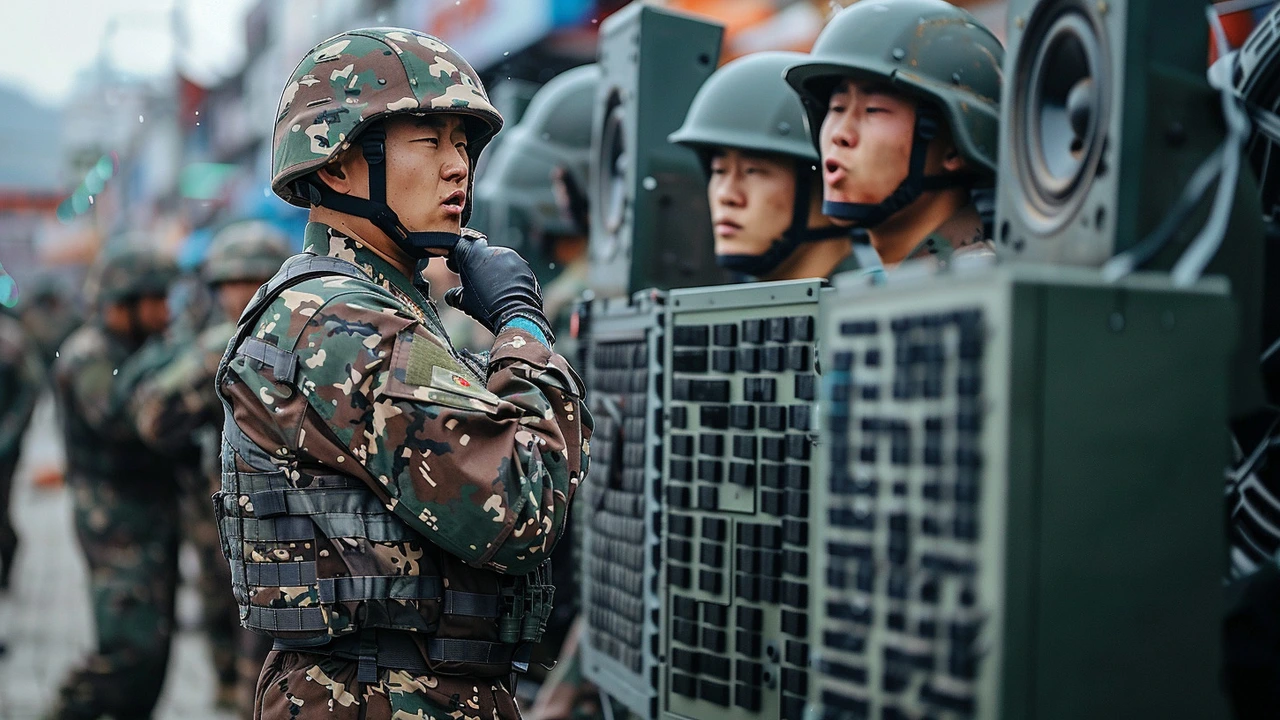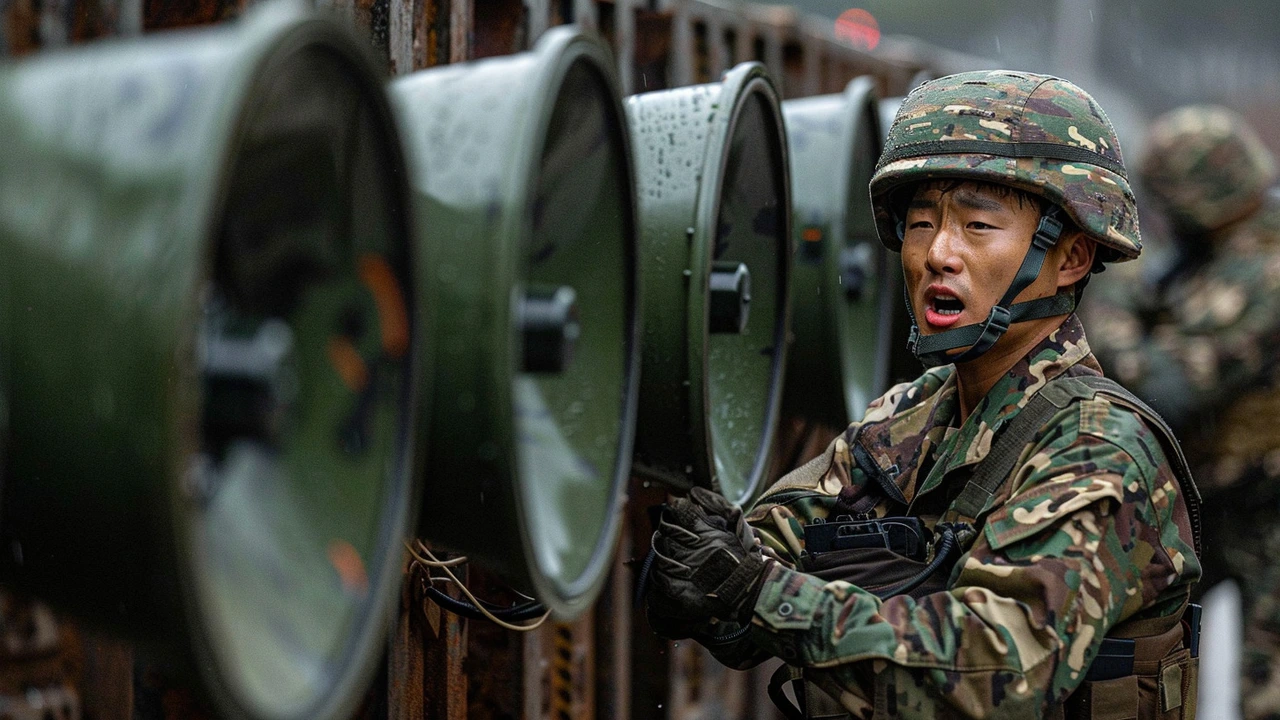Rising Tensions Along the Korean Peninsula
In a palpable sign of escalating tensions between South and North Korea, South Korea's military has indicated that the North is setting up its own loudspeakers along their heavily fortified border. This development follows closely on the heels of South Korea's decision to resume its provocative loudspeaker broadcasts on Sunday. These broadcasts feature a medley of news, critical commentary on the North Korean regime, and popular South Korean music.
The resumption of these broadcasts by South Korea serves as a form of retaliation against the North's unorthodox propaganda tactics carried out over the past few weeks. North Korea had sent more than a thousand balloons filled with refuse and manure drifting into South Korean territory. Pyongyang justified this unusual balloon campaign as a countermeasure to South Korean civilian groups who have been using similar balloons to disperse anti-North Korean propaganda leaflets across the border.
North Korea is notably hypersensitive to any form of external criticism, particularly that which targets the authoritarian rule of its leader Kim Jong Un. The increasingly tense tit-for-tat involving the exchange of loudspeaker broadcasts and balloon messages has only served to deepen the rift between the two Koreas. This situation unfolds against the backdrop of stalled diplomatic efforts aimed at addressing North Korea's nuclear ambitions.

Stalled Discussions and Growing Threats
Recent nuclear planning discussions held in Seoul saw officials from South Korea and the United States draft strategies to address what is perceived as a growing threat from North Korea. These talks, while necessary, highlight the fragile nature of relations on the Korean peninsula, making the current escalation even more concerning.
Amid these talks, Kim Yo Jong, the influential sister of Kim Jong Un, issued a stark warning. She accused the South of creating a “prelude to a very dangerous situation,” signaling an unspecified “new response” if the South's loudspeaker broadcasts continued and if civilian activists weren't reined in from flying propaganda leaflets into the North.
South Korea’s Joint Chiefs of Staff have maintained that the continuation of their broadcasts is contingent entirely upon North Korea's behavior. However, as both sides seem unwilling to stand down, the situation remains volatile and the possibility of further escalation looms large.
Historical Context of Propaganda Warfare
Borders between the two Koreas have been a flashpoint for conflict for decades. The use of loudspeakers for propaganda is a tactic that dates back to the Cold War era. Both nations have employed these broadcasts to sway the enemy's public opinion, spark internal dissent, and demoralize troops stationed along the border.
Historically, these loudspeaker wars have been intermittent, often correlating with broader political and military maneuvers within and between the two countries. Their recent resurgence heralds a return to the hyper-tense atmosphere reminiscent of previous high-stakes periods on the peninsula.
The content of these broadcasts often includes a mix of news reports and propaganda aimed at discrediting the other side. South Korea's inclusion of popular music, especially K-pop, in its broadcasts is a relatively modern tactic aimed at appealing to North Korean youth and soldiers, many of whom are reportedly fans of the genre despite it being outlawed in the North.

The Role of the United States
The involvement of the United States adds another layer of complexity to the conflict. American military presence in South Korea serves as both a stabilizing force and a point of contention for North Korea. U.S. officials have consistently reiterated their commitment to South Korean defense, a stance that has been met with aggressive rhetoric and actions from the North.
In their latest collaborative efforts, U.S. and South Korean officials revisited their tactical approaches, focusing on countering North Korea's growing capabilities, including its missile and nuclear programs. The discussions underscored the significance of a unified front in addressing the persistent threat posed by Pyongyang.
Civilian Activism and Its Impact
Civilian groups in South Korea have long played a role in the nation's propaganda efforts against the North. The practice of using balloons to spread anti-regime leaflets dates back decades and continues to be a source of significant tension. These activism-driven initiatives aim to inform North Koreans of the outside world's realities, undermining the regime’s propaganda that isolates and controls its populace.
However, these efforts have not come without controversy. Critics argue that such actions may provoke greater hostility from the North, putting South Korean lives at risk. Nonetheless, proponents believe that these leaflets are a crucial tool in the fight against Pyongyang’s oppressive regime, offering a rare glimpse of alternative realities to those living under Kim Jong Un's rule.

Speculating on Future Developments
The border loudspeaker standoff is yet another episode in the cyclical nature of inter-Korean relations. What lies ahead remains uncertain, but history suggests that both sides are unlikely to back down easily. The involvement of major players like the United States adds to the geopolitical stakes, making the outcome of this conflict even more critical.
As the world watches, the focus remains on how these events will unfold in the coming weeks. Will North Korea intensify its retaliatory actions, or will diplomatic efforts behind the scenes manage to de-escalate the situation? The region’s stability hinges on these questions, making the international community's role in mediating tensions more vital than ever.
For now, the echoing sounds of loudspeakers across the Demilitarized Zone (DMZ) serve as a sonic reminder of the fragile peace and the high stakes involved in this decades-old conflict. Until a resolution is reached, both sides seem poised to continue their propaganda war, each broadcast amplifying the deep-rooted mistrust that defines the Korean Peninsula's divided history.
